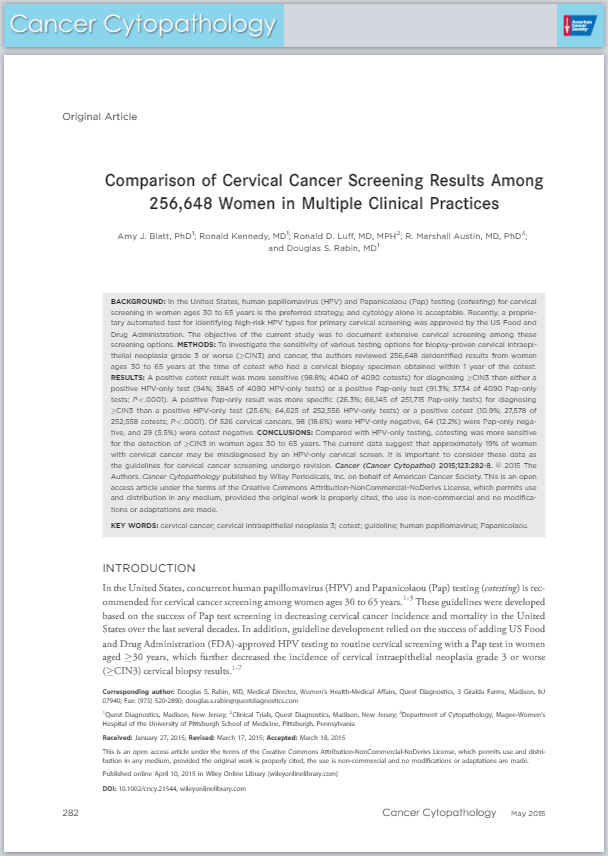USPSTF Considering Changes to Cervical Cancer Screening Guidelines That May Increase Risk of a Missed Diagnosis
Before the introduction of Pap testing, cervical cancer was the leading cause of cancer-related deaths for women in the United States, ahead of breast cancer. Thanks to Pap tests and testing for the Human Papillomavirus (HPV), cervical cancer now ranks 14th in frequency.
This is because of advancements in testing and supporting guidelines.Now, these gains for women’s health are under threat. The U.S. Preventive Services Task Force (USPSTF), a federally convened group, recently released draft guidelines that, if implemented, will reduce women’s access to the most effective approach to screening for cervical cancer: receiving both Pap and HPV together, also known as co-testing.The USPSTF now recommends that women 30-65 years of age receive a Pap test every three years or an HPV test every five years. They no longer recommend co-testing of HPV and Pap together for women in this age group.

Why is Co-Testing So Important?
During the exam, cells from the cervix are collected. An HPV test is then performed on the cells to find DNA of HPV, the virus that causes most cervical cancers. But only a Pap test involves looking at the actual cells to see if cancer is occurring or likely to. That’s why co-testing – which involves the same one-time sample collection – is so important.Well-established evidence, including a
Quest Diagnostics Health Trends study, indicates that screening co-testing is the best strategy for 30-65 years of age. This approach identifies more cervical pre-cancer and cancer than either test used alone and provides the most reassurance to women.
The study found that co-testing represented an approximate 3-fold improvement in the cancer detection rate compared to testing with HPV alone and that 1 in 5 women with cervical cancer were missed with HPV alone screening alone.Medical experts including the American College of College of Obstetricians and Gynecologists and the American Society for Colposcopy and Cervical Pathology agree, and recently issued a statement that affirms co-testing for women ages 30-65 is preferred.
You Can Influence the USPSTF: How to Submit a Comment Letter to the USPSTF Online
You can make your voice heard by submitting a comment letter to the USPSTF. You must submit comments by October 9, 20178 p.m. ET on October 13, 2017 (Updated: USPTF extended the comment period.)Step 1. Visit the
USPSTF comment page and follow the cues. Refer to the content below to help guide your responses.
Step 2. Type concise responses to each of the questions.
Note: You do not have to respond to each question. You can also type a letter in a different program and upload it. Some suggested talking points include:• I’m very concerned that the draft recommendations propose changes that do not include a grade for co-testing (Pap plus HPV).• The draft recommendations represent a significant change from current practice.• Large studies conducted in the United States indicate that screening with co-testing identifies more cervical pre-cancer and cancer than either test used alone.• These draft guidelines should be reviewed carefully by the clinical community.
Step 3. Click “Submit.”Learn more about the benefits of co-testing at
www.GoWithCotesting.com.
National Institutes of Health. NIH Fact Sheets: Cervical Cancer. https://www.report.nih.gov/nihfactsheets/viewfactsheet.aspx?csid=76. Updated March 29, 2013. Accessed September 26, 2017. Blatt AJ, Kennedy R, Luff RD, et al. Comparison of cervical cancer screening results among 256,648 women in multiple clinical practices. Cancer Cytopathology. 2015;123(5):282-288. The American Congress of Obstetricians and Gynecologists, Leading Women’s Health Care Groups Issue Joint Statement on USPSTF, September 13, 2017. https://www.acog.org/About-ACOG/News-Room/Statements/2017/Leading-Womens-Health-Care-Groups-Issue-Joint-Statement-on-USPSTF.
Your Privacy Choices





